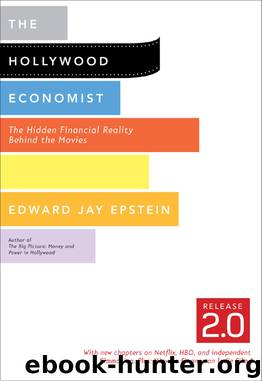The Hollywood Economist 2.0 by Edward Jay Epstein

Author:Edward Jay Epstein [Epstein, Edward Jay]
Language: eng
Format: epub
ISBN: 978-1-61219-051-8
Publisher: Melville House
Published: 2012-01-23T16:00:00+00:00
PART IV
HOLLYWOOD POLITICS
IN THE PICTURE
In November 2009, Oliver Stone literally put me in the picture. I was seated at an oval table under an eerie light in what purported to be the office of the Chairman of New York Federal Reserve Bank. As the meeting continued throughout the night, people around screamed about the “moral hazard” of saving a failing investment bank. At one point, there was even a call from the White House dooming the bank in question. The frenetic scene is no more than a consensual hallucination directed by Oliver Stone for the movie Wall Street 2: Money Never Sleeps. (A sequel to his 1987 Wall Street.) The magnificently wood-paneled room is actually the executive conference room of an insurance company, MetLife, which is serving as a location for this part of the filming. The eerie glow comes from powerful lamps ingeniously suspended from helium balloons above us. The shouting is coming from actors Frank Langella, Eli Wallach, and Josh Brolin. Although I had only a bit part in this drama, it provided me with an opportunity to see how a Hollywood movie is made from the vantage point of the set.
The project was initiated in 2005 by Edward R. Pressman, the producer of the original Wall Street, after he saw the fictional villain of Wall Street Gordon Gekko (portrayed by Michael Douglas) on the cover of Fortune, accompanied by a headline about the return of greed to Wall Street. Pressman reasoned that if eighteen years after the movie, Gekko was still the media’s icon for greed on Wall Street, a sequel was in order. He owned the rights for the sequel but sought to interest Twentieth Century Fox, which had distributed the original Wall Street. Getting a movie made in Hollywood when the hero is not a comic book character was not an easy task. Just getting a script that was acceptable to Fox took four years—and three different (and very expensive) writers. Even then Fox’s approval was conditional on the stars and director, as are almost all movie deals. Pressman persuaded Michael Douglas to again play Gekko, a role for which he had won the Oscar in 1988, and Oliver Stone (who had dropped out of the project earlier) to direct. Fox then agreed to finance it. Part of the $67 million budget could be retrieved from New York State and New York City’s tax credit programs (which effectively reimburse 35 percent of the production budget spent in New York).
The Federal Reserve scenes were filmed over a long weekend about midway in the eleven-week shooting schedule. Through the seemingly endless retakes in which actors repeat virtually the same lines while extras behind them—each of whom is called by a number rather than a name—move to the exact same “mark,” or position, Stone gradually perfects the illusion. Between each take, the time on the grandfather clock in the office is reset to the exact time as it was at the start of the previous scene. The process is not unlike the never-ending day in Groundhog Day.
Download
This site does not store any files on its server. We only index and link to content provided by other sites. Please contact the content providers to delete copyright contents if any and email us, we'll remove relevant links or contents immediately.
Nudge - Improving Decisions about Health, Wealth, and Happiness by Thaler Sunstein(7659)
Deep Work by Cal Newport(6969)
Principles: Life and Work by Ray Dalio(6296)
The Doodle Revolution by Sunni Brown(4715)
Factfulness: Ten Reasons We're Wrong About the World – and Why Things Are Better Than You Think by Hans Rosling(4713)
Eat That Frog! by Brian Tracy(4484)
Thinking in Bets by Annie Duke(4185)
Hyperfocus by Chris Bailey(4087)
Visual Intelligence by Amy E. Herman(3753)
Writing Your Dissertation in Fifteen Minutes a Day by Joan Bolker(3696)
Ogilvy on Advertising by David Ogilvy(3554)
Hidden Persuasion: 33 psychological influence techniques in advertising by Marc Andrews & Matthijs van Leeuwen & Rick van Baaren(3519)
How to Win Friends and Influence People in the Digital Age by Dale Carnegie & Associates(3519)
How to win friends and influence people by Dale Carnegie(3438)
The Pixar Touch by David A. Price(3389)
Schaum's Quick Guide to Writing Great Short Stories by Margaret Lucke(3347)
Deep Work: Rules for Focused Success in a Distracted World by Cal Newport(3183)
Work Clean by Dan Charnas(3080)
The Slow Fix: Solve Problems, Work Smarter, and Live Better In a World Addicted to Speed by Carl Honore(2976)
